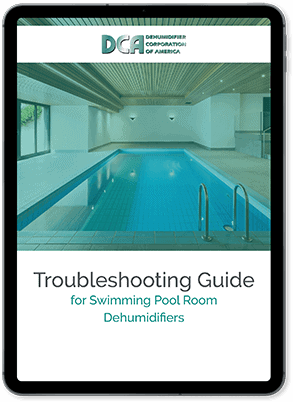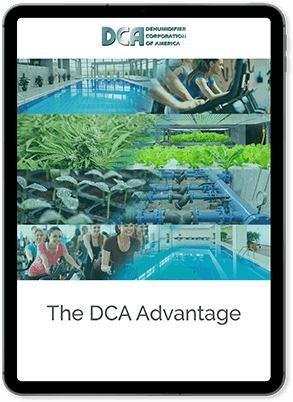Outdoor air-cooled remote condensers are used as the cooling component (A/C) of an indoor pool room dehumidifier. Pool dehumidifiers deliver warm dry air to the pool room when operating. With the addition of an outdoor remote condenser the dehumidifier now can supply warm or cool dry air back to the pool room to help control the temperature and is controlled by a wall mounted automatic change over thermostat. In most cases this system will provide the proper room temperature needed to minimize pool water evaporation and provide a comfortable environment for swimmers. In very warm climates they often supplement the pool room primary A/C system.
Location of an Outdoor Remote Condenser
The ideal location of an outdoor remote condenser should be within 50 feet of the installation of the pool dehumidifier. (contact factory if location is over 50 ft.) Elevation separation, between the remote condenser and the pool dehumidifier, is also a factor. A separation of over 15 vertical feet, where the dehumidifier is higher than the remote condenser, should be discussed with the factory before proceeding. Even though remote condenser operation is considered quiet, if at all possible avoid locations near bedrooms or where the quality of life could be impacted. The installation location should allow free air flow through the remote condenser. The area around the remote condenser should be free from close walls, vegetation, low hanging branches, or places where the deposit of lawn clippings could occur. See installation and service manual for further instructions.
Remote Condenser Installation Recommendations
When a remote condenser from DCA arrives at your facility, it will still be packaged for transport, meaning the legs will not be extended. Inspect the unit for any damage, such as the bent header seen to the right. Report any damage to the carrier immediately.
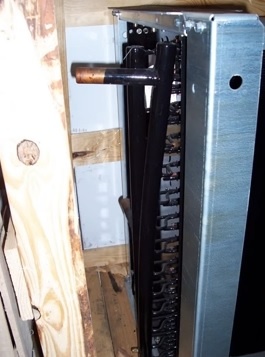
The top header will receive the hot gas, while the bottom header will serve as the liquid return line. Adapters will be needed at the headers. The line set is sized for distances up to 50 feet; if the distance is greater, contact DCA and have the dehumidifier’s serial number handy for instructions on how to increase both the line sizes (if needed) and the amount of extra refrigerant charge.
Care must be taken to minimize the amount of 90 degree elbows used in both lines. In all cases use sweep elbows or form the elbows with the tubing being careful not to bend the tubing.
In most cases the hot gas line should be insulated with Armaflex tubing insulation. In some cases it is also advised that the liquid line be insulated as well. See installation and service manual for further recommendations.
DCA dehumidifiers come factory-charged, and the line set and remote condenser must be evacuated and receive a field charge with the proper refrigerant, which is shown on a decal affixed to the dehumidifier. Before proceeding, read and understand the charging procedure for the dehumidifier and remote condenser in the u.
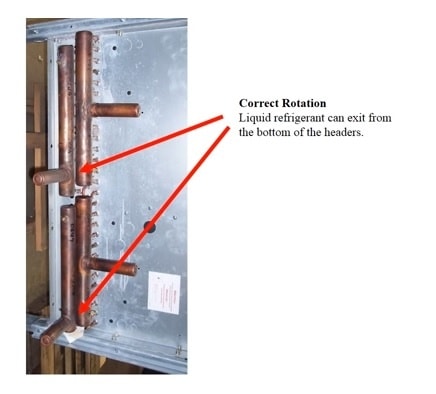
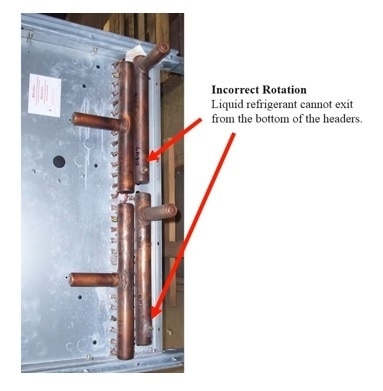
Correct connections of the refrigerant lines are critical. The position in the picture on the right is correct: The liquid return is at the bottom of the headers. The position shown in the picture on the left is incorrect: The liquid is not coming out from the bottom of the headers. If the condenser is connected to 3-phase power verify that the fan rotation is correct.
Remote Condensers and Alternative cooling methods for pool dehumidifiers
While the vast majority of air-cooled pool room dehumidifiers use outdoor remote condensers as their cooling component, other methods are available. If the pool dehumidifier has the optional pool water heating assist feature, cool air will be delivered when in the pool water heating assist mode with 100% of the heat of rejection being applied to pool water heating. If a heat pump ground water loop, cooling tower or other means of a heat dissipation source is available, the pool water assist dehumidifiers can be set up with an optional internal tube and tube heat exchanger to provide room cooling.
All DCA dehumidifiers are manufactured to be remote-condenser ready, with all valves and electrical devices in place for connection to an outdoor remote condenser. Our dehumidifiers are set up as full flooding systems which means they can operate down to minus 20 degrees if needed.
DCA offers a wide range of remote condensers to meet the needs of various applications and industries; our product line includes the LORC Series, LNH Series, LNQ Series, LNX Series, and LNL Series, as well as an ORC Series.
DCA remote condensers can accommodate outdoor ambient temperatures as high as 115 degrees and altitudes of six thousand feet and more. Equally important is that the operating sound levels can be had at very low decibels where quality of life can be a factor. DCA can provide a remote condenser for any application.
Learn More
To read more about proper installation procedures for our remote condensers, check out our installation manual or reach out to the team today; we’re on hand to answer any questions you may have.




